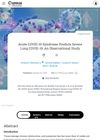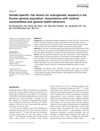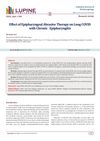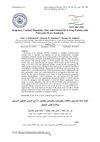
Search
for
Sort by
Research
930-960 / 1000+ results

research Acute COVID-19 Syndrome Predicts Severe Long COVID-19: An Observational Study
Older, obese people with many COVID-19 symptoms are more likely to suffer from severe long-term COVID-19 effects.

research Evaluation of the Effects of Adding an Adipose Tissue-Derived Stromal Vascular Fraction to Platelet-Rich Plasma Injection in the Treatment of Androgenetic Alopecia: A Randomized Clinical Trial
Adding stromal vascular fraction to platelet-rich plasma injections did not significantly improve hair growth in androgenetic alopecia treatment.

research Research Advances of Tissue-Derived Extracellular Vesicles in Cancers
Tissue-derived extracellular vesicles are crucial for cancer diagnosis, prognosis, and treatment.

research Complementary Strategies to Promote Hair Regrowth in Post-COVID-19 Telogen Effluvium
Different methods, including stress management, healthy diet, supplements, and treatments like minoxidil, can help hair grow back after COVID-19 related hair loss.
research Glycyrrhizic Acid Attenuates Stem Cell-Like Phenotypes of Human Dermal Papilla Cells
Glycyrrhizic acid may help reduce unwanted hair growth.

research In Vivo Hair Growth Promotion Effects of Ultra-High Molecular Weight Poly-γ-Glutamic Acid from Bacillus Subtilis (Chungkookjang)
Ultra-high molecular weight poly-γ-glutamic acid may help promote hair growth.

research Human Placental Extract Exerts Hair Growth-Promoting Effects Through the GSK-3β Signaling Pathway in Human Dermal Papilla Cells
Human placental extract may help hair growth by affecting certain cell signals and could be more effective with minoxidil.

research Gender-Specific Risk Factors for Androgenetic Alopecia in the Korean General Population: Associations with Medical Comorbidities and General Health Behaviors
AGA risk factors include age, smoking, hypertension for men, and age, dyslipidemia for women; lifestyle changes may help prevention.

research Effect of Epipharyngeal Abrasive Therapy on Long COVID with Chronic Epipharyngitis
Epipharyngeal Abrasive Therapy helps reduce symptoms in Long COVID patients with chronic epipharyngitis.
research Inflammatory Cytokine TNFα Promotes the Long-Term Expansion of Primary Hepatocytes in 3D Culture
TNFα helps grow and maintain liver cells in 3D culture for a long time.

research Idiopathic Hirsutism: Androgen Role and Treatment Options
The document concludes that more research is needed to understand excessive hair growth in women with normal hormone levels and regular ovulation.

research Non-Polycystic Ovary Syndrome–Related Endocrine Disorders Associated with Hirsutism
Hirsutism can be caused by various conditions besides PCOS, and it's important to treat the underlying issue and manage symptoms with medication and cosmetic approaches.

research Literature Review on Atopic Dermatitis and Related Studies
Atopic dermatitis may have genetic causes and can be treated with pharmacologic methods, glycerin creams, and controlling Staphylococcus aureus colonization.

research Natural Killer Group 2 Type D (NKG2D) Gene Polymorphism in Systemic Lupus Erythematosus - Suez Canal Region, Egypt
NKG2D gene polymorphism doesn't affect SLE risk but may influence symptoms like rash and hair loss.

research Retinoids Putting the 'A' in Alopecia
Vitamin A may influence hair loss conditions like alopecia, but more research is needed to understand how.

research Ontogenetic Transition in Fetal Wound Transforming Growth Factor-Beta Regulation Correlates with Collagen Organization
Fetal wound healing changes with development, affecting inflammation and collagen, which may influence scarring.

research The Aetiopathogenesis of Acne Vulgaris: What's New?
Acne is caused by multiple factors including oil production, bacteria, inflammation, and possibly diet and environment.

research The Epidermal Vitamin D System and Innate Immunity: Some More Light Shed on This Unique Photoendocrine System?
Vitamin D made by the skin plays a role in immune defense and skin health, and more research is needed to understand its full effects.

research Hair Growth Promotion by Delta-Opioid Receptor Activation
Activating δ-opioid receptors can help hair grow.

research Safety of Janus Kinase Inhibitors in Patients with Alopecia Areata: A Systematic Review
JAK inhibitors for alopecia areata are linked to minor side effects like headache and acne, but not to an increased risk of serious adverse events.

research Flightless I Exacerbation of Inflammatory Responses Contributes to Increased Colonic Damage in a Mouse Model of Dextran Sulfate Sodium-Induced Ulcerative Colitis
High levels of the protein Flightless I worsen ulcerative colitis symptoms in mice.

research Chemotherapy-Induced Alopecia
Many patients find hair loss from chemotherapy very distressing, and while treatments like minoxidil and scalp cooling may help, there is no sure way to prevent it.

research Fisetin Promotes Hair Growth by Augmenting TERT Expression
Fisetin, a type of polyphenol, may help hair grow by increasing certain protein activities in cells.

research Sequential Scalp Assessment in Hair Regeneration Therapy Using an Adipose-Derived Stem Cell-Conditioned Medium
Using a special stem cell formula on the scalp once a month for six months helped people with hair loss grow more hair.

research Prolactin: An Emerging Force Along the Cutaneous–Endocrine Axis
Prolactin may play a significant role in skin and hair health and could be a target for treating skin and hair disorders.

research Effect of Miscanthus Sinensis Var. Purpurascens Flower Extract on Proliferation and Molecular Regulation in Human Dermal Papilla Cells and Stressed C57BL/6 Mice
Miscanthus sinensis flower extract may help promote hair growth and prevent hair loss.
research Lactobacillus Paracasei HY7015 and Lycopus Lucidus Turcz. Extract Promotes Human Dermal Papilla Cell Cytoprotective Effect and Hair Regrowth Rate in C57BL/6 Mice
The substances improved hair regrowth and protected hair cells in humans and mice.

research Dehydrogenase, Cortisol, Dopamine, Zinc, and Vitamin D3 in Iraqi Patients with Polycystic Ovary Syndrome
PCOS patients have higher LDH and lower cortisol, dopamine, zinc, and vitamin D3, which may contribute to their symptoms and obesity.
research Werner's Syndrome: Incidental Finding During Pregnancy
A pregnant woman with Werner's syndrome died during childbirth, but her baby survived and did not have the syndrome.